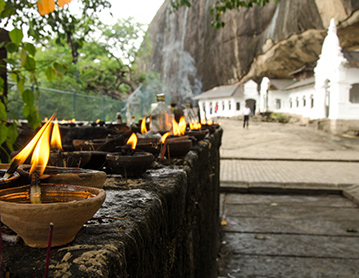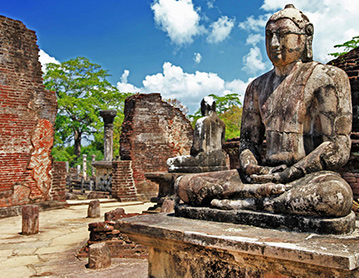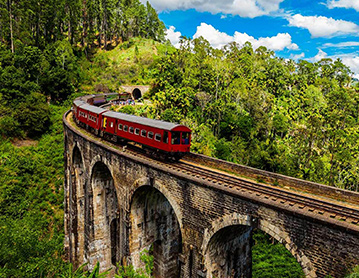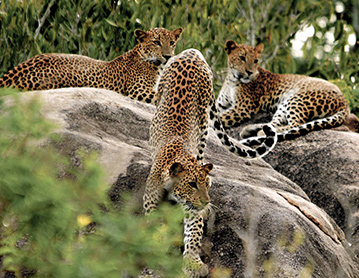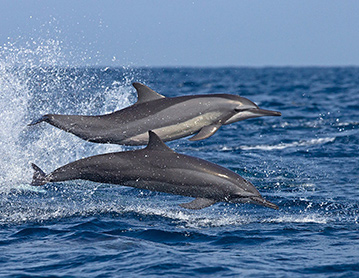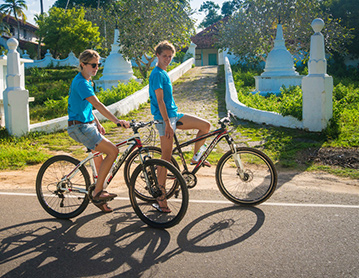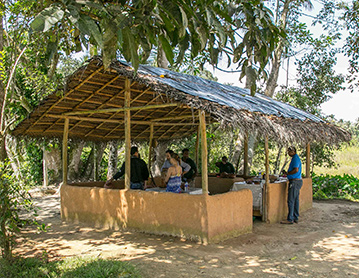Overview
Our Essential Sri Lanka special offer is a two-week tour of Sri Lanka which takes you to: the Cultural Triangle, home to the island’s most awe-inspiring historic monuments; Kandy, Sri Lanka’s last royal capital; Wellawaya on the edge of the central tea hills, and Yala National Park, before ending with three nights on the spectacular beaches of the south coast where whale watching and a variety of water-sports are on offer. With savings of up to 19%, this is a special offer Sri Lanka tour not to be missed, particularly for first-time visitors to the island.
To ensure total flexibility, no activities have been included in the cost of this special offer. Your travel consultant can help you to organise any activities you wish to pre-confirm before your arrival in Sri Lanka.
Highlights
- Save up to 19% on this traditional island tour
- Relax and indulge in water-sports on the south coast
- Spot leopards and elephants in Yala National Park
- Experience the glorious vistas of Sri Lanka’s tea hills
- Explore the historic city of Kandy
- See Sri Lanka’s most awe-inspiring cultural sites
Package includes
- Accommodation in a shared double / twin room on a BB basis in Level 1 ‘Safe and Secure’ hotels
- English-speaking chauffeur-guide and vehicle for the duration of the tour (including leisure days)
- Both airport transfers
- Customer Care for the duration of your tour
- Covid-19 insurance and healthcare package including two PCR tests per client and health & safety equipment
Terms & Conditions
- Valid until 31st December 2024
- Price shown is based on two people sharing and may be subject to change
- There may be additional charges required relating to coronavirus H&S protocols
- See our Booking Conditions for more details
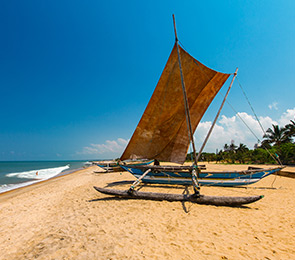
Day 1 & 2 Negombo, North-West
Upon arrival at the airport, transfer to the nearby coastal town of Negombo. Spend the first two nights on the edge of a tranquil lagoon. Spectacular sunsets can be expected on these west coast beaches.
Accommodation: Villa Hundira

Day 3, 4 & 5 Sigiriya, Cultural Triangle
Travel north to the Cultural Triangle. Spend the next three days exploring the many historic sites in this region, including the awe-inspiring Sigiriya Rock Fortress, the 2,000-year-old cave paintings and Buddha statues of Dambulla Cave Temple and Polonnaruwa, Sri Lanka’s medieval citadel.
Accommodation: Amaya Lake
Recommended Activities: The Monkey Kingdom of Polonnaruwa , Minneriya National Park , Sigiriya Rock Fortress , Polonnaruwa , Dambulla Cave Temple

Day 6 & 7 Kandy
Head down to Kandy, Sri Lanka’s last royal capital and now a bustling, vibrant city with a proud artistic heritage. Explore relics of British colonial rule (including the beautiful Royal Botanical Gardens) and visit the iconic Temple of the Tooth. Kandy’s clamouring bazaars are also fascinating to visit, especially for foodies, and the region is famous for its traditional arts and crafts such as Kandyan dancing.
Accommodation: Bougainvillea Retreat
Recommended Activities: Kandy tea hills trek , Royal Botanical Gardens , Kandyan Cultural Show , Kandy Temple and City Walk
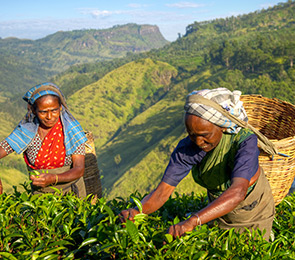
Day 8 & 9 Wellawaya, Hill Country
Journey through island’s spectacular central hill country, either by car, or by rail should you wish to follow in the footsteps of the British planters – this train journey has been described by Lonely Planet as one of the most beautiful in the world. Your final destination is Wellawaya on the south-eastern edge of the hills. Over the next two days, enjoy the cooler climes of this region, either soaking in the views by the pool or exploring the surrounding landscape on foot.
Accommodation: 98 Acres Resort
Recommended Activities: Nine Arch Bridge
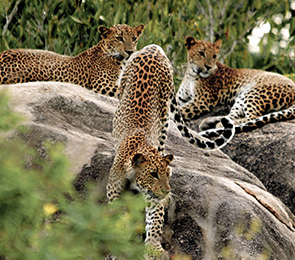
Day 10 & 11 Tissamaharama, Tissa & Kataragama
Wind out of the hills and down to Yala National Park, one of Sri Lanka’s largest and most beautiful parks which is one of the best places in the world to see leopards. You have time for four jeep drives in the park during your stay, and as well as leopards you can spot many different animals including elephants, sloth bears, crocodiles and a wide variety of birds.
Accommodation: Flameback Eco Lodge
Recommended Activities: Yala National Park
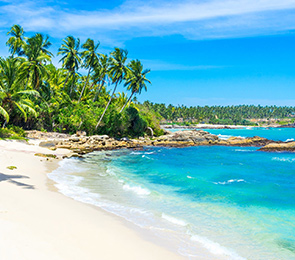
Day 12, 13 & 14 Mirissa, South Coast
End your holiday with three nights on Sri Lanka’s south coast. Idyllic tropical beaches await, with whale watching excursions and a variety of water-sports to delight those who want to be active. Historic Galle Fort is just a short drive away, and the adventurous may wish to go cycling through the scenic inland countryside or take a traditional cooking class – as always, the choice is yours.
Accommodation: Lantern
Recommended Activities: Whale Watching in Mirissa , Galle Boats and Bikes , Guided walk of Galle Fort: past to present , Guided Walk of Galle Fort History and Architecture , Galle Dutch Fort
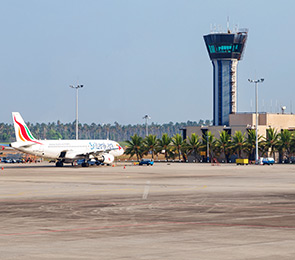
Day 15 Airport
Today, your chauffeur-guide will pick you up and take you to the airport in time to catch your flight home.
Villa Hundira
Negombo, North-West
Villa Hundira is a 12-bedroom boutique hotel nestled in tropical gardens overlooking the picturesque Negombo Lagoon. Situated in the village of Thalahena, it lies just 20 minutes away from Colombo’s international airport, making it a good spot to recuperate after a long flight.
4.6
Amaya Lake
Kandalama, Cultural Triangle
Amaya Lake is a simple hotel of four-star standard which enjoys a peaceful and beautiful setting by the banks of Kandalama Lake in Sri Lanka’s Cultural Triangle. An excellent eco-hotel with a personal feel that offers low-level cabanas in tranquil woodland.
4.5
Bougainvillea Retreat
Victoria, Kandy
Bougainvillea is a peaceful holiday retreat in tropical gardens within Victoria Golf & Country Resort. Accommodation is in well-appointed bedrooms set within the main house and separate cottages opening on to lush green gardens and mountain views.
4
98 Acres Resort
Ella, Hill Country
The 98 Acres Resort is a 12 room eco-friendly, boutique hotel in Ella set amidst tea covered hills with magnificent views of the southern plains, Ella rock and Little Adam’s Peak. Accommodation is in individual stone chalets and the lounge and restaurant pavilion has breathtaking views.
4.3
Flameback Eco Lodge
Tissamaharama, Tissa, Uda Walawe and Kataragama
Flameback Eco Lodge is a highly-regarded eco lodge which offers a glamping experience in a bird sanctuary on the shores of the tranquil Weerawila Lake in Sri Lanka’s Deerp South. This luxury tented lodge combines excellent levels of comfort with a true safari feel
The Monkey Kingdom of Polonnaruwa
Polonnaruwa, Cultural Triangle
Quite apart from the incredible ruins of this medieval city, Polonnaruwa is home to a large monkey population who were famously featured in Disney’s engaging documentary film ‘Monkey Kingdom’. Polonnaruwa is a gloriously majestic backdrop for this experience, which allows you to closely observe the three diurnal primates of Sri Lanka: grey langur, purple-faced leaf monkey and toque macaque. Although these creatures can be seen in various parts of the island, this is one of the best places for travellers to get up close and personal with the monkeys of Sri Lanka.
Minneriya National Park
Habarana, Cultural Triangle
Minneriya National Park is a small but popular wildlife park home to a wide range of Sri Lanka’s wildlife. It is also the site of the world-renowned wildlife event ‘The Elephant Gathering’.
Sigiriya Rock Fortress
Sigiriya, Cultural Triangle
Sigiriya is one of the most dramatic and inspiring historical locations in the world, a huge rock fortress rising impossibly from Sri Lanka’s central plains, and possessed of a glorious history that has caused millions of travellers to gape in wonder.
Dambulla Cave Temple
Dambulla, Cultural Triangle
Dambulla Cave Temple is one of the most popular religious cultural sites in Sri Lanka, attracting tourists from across the globe. A sacred pilgrimage site for 22 centuries, it is the largest, best-preserved cave-temple complex in Sri Lanka. This World Heritage site has the largest number of Buddha statues all housed in one place, including a colossal, 14-metre-long figure of the recumbent Buddha carved out of the rock.
Polonnaruwa
Polonnaruwa, Cultural Triangle
The well-preserved ruins of Polonnaruwa, Sri Lanka’s medieval royal capital, are one of the country’s most prominent cultural sites. You can spend several hours wandering freely between the various ruined temples, imposing Buddha statues and royal bathing pools.
Kandy tea hills trek
Deltota, Kandy
The tea estates around Deltota in the Kandyan foothills are some of the oldest in Sri Lanka and include Loolecondera, James Taylor’s tea plantation which was the first to be developed in Sri Lanka. These tea estates are also little-visited compared to those in the heart of Sri Lanka’s hill country, so you will be largely undisturbed as you trek through this glorious scenery with your guide.
Royal Botanical Gardens
Data to be Given
The Peradeniya Royal Botanical Gardens, located just outside of Kandy, are Sri Lanka’s largest landscaped gardens, spanning over 60 hectares, and can lay claim to being the finest in Asia. They will delight anybody who loves to see nature showcased at its best.
Kandy Temple and City Walk
Kandy
Walk back in time through the historic hill capital of Kandy and visit the temple that houses Sri Lanka’s most valued Buddhist relic. Kandy is a place steeped in history, culture and religion. Although the effects of modernisation are visible, peek into the heart of this hill country capital and you will see that the core of this cool city remains traditional and friendly.
Kandyan Cultural Show
Kandy
Watch a Kandyan cultural show and be awed by the spectacular dance, acrobatics, costumes and music. Held in Kandy town, this cultural show depicts various forms of Kandyan dancing which was once native to the area but has now spread to different regions of the island. Originated from a dance performed by Indian shamans who came to the island, Kandyan dancing plays an important role in Sri Lankan culture and is a much-anticipated event during perahera processions. During the show, you will see several dances which depict the graceful movements of birds and animals, which trace their origins back to the ancient ritual known as the Kohomba Kapkariya, as well as energetic acrobatic performances where the men perform a series of leaping pirouettes and stunts such as plate-spinning and the dramatic ‘fire walk’ which ends the show.
Nine Arch Bridge
Ella, Hill Country
Nine Arch Bridge in the Sri Lanka highlands town of Ella regularly takes centre stage in one of the most iconic pictures in the hill country. It is part working railway viaduct, part tourist photo opportunity. This setting, beloved by thousands of Instagram accounts, somehow conveys the relaxed vibe that makes Sri Lanka one of the most treasured holiday destinations in the world.
Yala National Park
Yala National Park, Yala
Yala National Park is one of the largest and certainly the most popular national park in Sri Lanka, and has the highest density of leopards anywhere in the world. Hidden away in the far south-east of the country, it comprises five separate blocks covering 141sqkm.
Whale Watching in Mirissa
Mirissa, South Coast
Go whale watching in Sri Lanka, acclaimed as one of the best places in the world to see whales. Spot dolphins, sperm whales and blue whales near Mirissa. The island’s shoreline lies unusually close to the continental shelf, the point when the ocean floor drops dramatically and where larger marine life is found, and so it does not take too long to reach these deep waters from Sri Lanka’s western, southern and eastern coastlines. Whale and dolphin watching is possible from Kalpitiya, Bentota and Mirissa between December and April, and from Trincomalee and Pasikudah on the east coast between June and August, but Mirissa is widely thought of as the best place for whale watching in Sri Lanka.
Galle Guided Bicycle Trails
Galle, Galle Coast
Galle’s rural inland landscape is largely unfrequented by tourists who visit this region, as they are often more preoccupied with visiting the UNESCO World Heritage Site of Galle Fort, or relaxing on the popular beaches along the Galle Coast. However, the countryside around Galle is truly picturesque and is particularly nice to explore if you are looking to discover the ‘authentic’ Sri Lanka which is sometimes hidden on the tourist trail – cycle past lush green paddy fields dotted with water buffalo, bright white egrets and vibrant kingfishers, sloping tea plantations, rice fields, small villages, temples and colourful gardens growing spices and fruit.
Traditional Sri Lankan Cooking Class
Galle, Galle Coast
Learn how to make rice and curry, Sri Lanka’s delicious and underrated traditional cuisine, which is overshadowed on the international culinary stage by the food of its neighbours, such as India. Although it sounds simple, rice and curry is actually a complex dish comprised of seven different elements, including curries, spiced vegetables in a variety of textures, sambols, chutneys and rice.
Galle Dutch Fort
Galle Fort, Galle Coast
Galle Fort is a UNESCO World Heritage Site, originally built by the Portuguese in the 16th century and then further developed by the Dutch and the British over the next 350 years. It covers nearly 4sqkm and is protected by 12 bastions and connecting ramparts. During the early 18th century, the Old Dutch Gate was the entrance to the Fort, but subsequently the British built the Main Gate that is still used today. Buildings of interest include the Dutch Reformed Church, All Saints Church, Amangalla Hotel (formerly the New Oriental Hotel),the lighthouse and bell tower. The Dutch also developed what was then an innovative tide-based sewage-system within the Fort.
Guided walk of Galle Fort: past to present
Galle Fort, Galle Coast
Discover Sri Lanka’s colonial history during this Galle Fort walking tour. Hear thrilling tales of the people and diverse cultures that have shaped one of Sri Lanka’s most popular landmarks.
Guided Walk of Galle Fort History and Architecture
Galle Fort, Galle Coast
One of the most popular holiday destinations in Sri Lanka, Galle Fort is a UNESCO World Heritage Site which once served as a key trading port for the European colonial powers that occupied most of the island for over 300 years between the 16th and 19th centuries. Although first built by the Portuguese, it is commonly referred to as the Dutch Fort, as it was they who heavily fortified it in the 1700s to include ramparts constructed from granite and coral, 14 bastions and cannons to protect the port from invading ships. When the British took control in the 19th century they constructed a variety of administrative buildings, as well as the ‘New Oriental Hotel’ (now called Amangalla),one of the first hotels in Asia.
Galle Dutch Fort
Galle Fort, Galle Coast
Galle Fort is a UNESCO World Heritage Site, originally built by the Portuguese in the 16th century and then further developed by the Dutch and the British over the next 350 years. It covers nearly 4sqkm and is protected by 12 bastions and connecting ramparts. During the early 18th century, the Old Dutch Gate was the entrance to the Fort, but subsequently the British built the Main Gate that is still used today. Buildings of interest include the Dutch Reformed Church, All Saints Church, Amangalla Hotel (formerly the New Oriental Hotel),the lighthouse and bell tower. The Dutch also developed what was then an innovative tide-based sewage-system within the Fort.
Galle Boats and Bikes
Gal Oya, East Coast
Feeling active? Leave the beaches of Galle behind and explore its inland rural beauty by boat and by bike. Galle’s inner landscape is covered in patches of jungle, rice paddies, cinnamon plantations, lowland tea fields and quaint mud roads joining small villages, and is home to beautiful tropical plants and lots of Sri Lanka’s wildlife.
Whale Watching in Mirissa
Mirissa, South Coast
Go whale watching in Sri Lanka, acclaimed as one of the best places in the world to see whales. Spot dolphins, sperm whales and blue whales near Mirissa. The island’s shoreline lies unusually close to the continental shelf, the point when the ocean floor drops dramatically and where larger marine life is found, and so it does not take too long to reach these deep waters from Sri Lanka’s western, southern and eastern coastlines. Whale and dolphin watching is possible from Kalpitiya, Bentota and Mirissa between December and April, and from Trincomalee and Pasikudah on the east coast between June and August, but Mirissa is widely thought of as the best place for whale watching in Sri Lanka.

.jpg)
.jpg)
.jpg)
.jpg)
.jpg)
.jpg)
.jpg)
.jpg)
.jpg)
.jpg)
.jpg)
.jpg)
.jpg)
.jpg)
.jpg)
.jpg)
.jpg)



.jpg)





